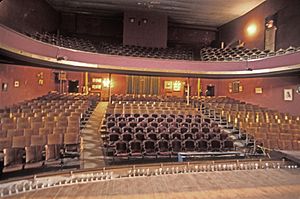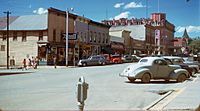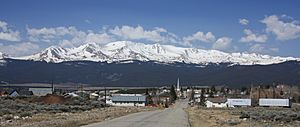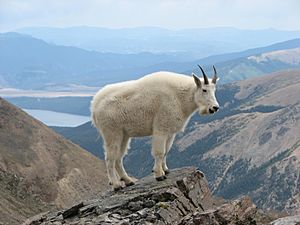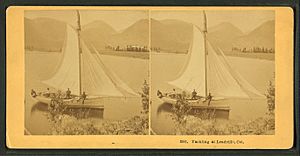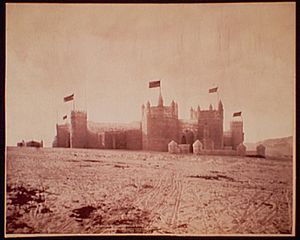Leadville, Colorado facts for kids
Quick facts for kids
Leadville, Colorado
|
|
|---|---|

Downtown Leadville
|
|
| Nickname(s):
The Two-Mile-High City, Cloud City
|
|
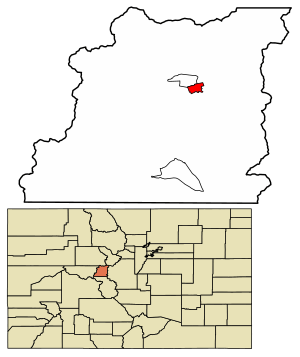
Location of the City of Leadville in Lake County, Colorado
|
|
| Country | United States |
| State | Colorado |
| County | Lake |
| City | Leadville |
| Founded | 1877 |
| Incorporated | February 18, 1878 |
| Government | |
| • Type | Statutory city |
| Area | |
| • Total | 1.17 sq mi (3.04 km2) |
| • Land | 1.17 sq mi (3.04 km2) |
| • Water | 0.00 sq mi (0.00 km2) |
| Elevation | 10,154 ft (3,095 m) |
| Population
(2020)
|
|
| • Total | 2,633 |
| • Density | 2,250/sq mi (866.1/km2) |
| Time zone | UTC−7 (Mountain (MST)) |
| • Summer (DST) | UTC−6 (MDT) |
| ZIP Codes |
80429 (PO Box), 80461
|
| Area code(s) | 719 |
| FIPS code | 08-44320 |
| GNIS feature ID | 2411641 |
|
|
|
Leadville (/ˈlɛdvɪl/ LED-vil) is a city in Colorado, United States. It is the main town and only official city in Lake County. In 2020, about 2,633 people lived here. Leadville is very high up, at about 10,119 feet (3,084 m) above sea level. It is the highest incorporated city in the United States. Two of Colorado's tallest mountains are right next to it.
Leadville used to be a busy silver mining town located in the Rocky Mountains. It sits near where the Arkansas River begins. The Leadville Historic District is a special area that was recognized in 1961. It has many old buildings and places from Leadville's mining days. In the late 1800s, Leadville was the second-largest city in Colorado, after Denver.
Contents
History of Leadville
Early Settlement and Gold Rush
People first settled in the Leadville area in 1859. This happened when gold was found in California Gulch during the Pike's Peak Gold Rush. By 1860, a town called Oro City (which means "gold city" in Spanish) quickly grew. A year later, over 5,000 people lived there. But this gold rush didn't last long. The easy-to-find gold soon ran out, and Oro City became much smaller.
Miners noticed that a heavy black sand made it hard to find gold. In 1874, they discovered this sand was actually a lead mineral called cerussite, which had a lot of silver in it. Prospectors followed the cerussite to where Leadville is today. By 1876, they had found many silver-lead deposits.
Horace Tabor, who later became known as the "Leadville Silver King," and his wife Augusta were among the first prospectors in Oro City. Horace tried to find minerals, while Augusta worked as a cook, laundress, banker, and postmistress.
Founding the City of Leadville
Leadville was officially started in 1877 by mine owners Horace Tabor and August Meyer. This was at the beginning of the Colorado Silver Boom. The town was built on flat, empty land below the tree line. The first miners lived in simple tents near the silver deposits. At first, the settlement was called Slabtown. But when people asked for a post office, they chose the name Leadville.
By 1880, Tabor and Meyer's new town had gas lights, water pipes, and 28 miles of streets. It also had five churches, three hospitals, six banks, and a school for 1,100 students. Many business buildings were made with bricks brought in by wagons.
The town's first newspaper was The Reveille in 1878. It was a weekly paper. Soon after, another paper called The Eclipse started. The Chronicle was the town's first daily newspaper. It was also the first in America to have a full-time female reporter. This paper helped to expose criminals and make the town safer.
The first saloon opened in early 1877, and many more followed. "The Coliseum Novelty" was the first theater to open that same year. It offered rooms to sleep upstairs and had many shows. These included dancing, dogfights, cockfighting, wrestling, and boxing. It also had rooms for gambling. In June 1881, it burned down.
Ben Wood opened the first proper theater, Wood's Opera House, in 1878. It had a thousand seats and was a fancy place where gentlemen took off their hats. Less than a year later, Wood opened the Windsor Hotel. His opera house was considered the biggest and best theater in the West for a while.
Horace Tabor's Opera House was the most expensive building in Colorado at the time. Building materials were brought from Denver by wagons. This huge three-story opera house, made of stone, brick, and iron, opened on November 20, 1879. Tabor, who was from Vermont, became the town's first mayor. After getting rich, he was worth about 10 million dollars and was known for his fancy lifestyle.
In 1883, Horace Tabor divorced his wife of 25 years. He then married Baby Doe McCourt, who was half his age. Tabor was a US senator by then, and his divorce and new marriage caused a big scandal. Tabor, one of Colorado's richest men, lost his money when a law called the Sherman Silver Purchase Act was cancelled. This caused the Panic of 1893. He died without money, but he believed the price of silver would go up again. Legend says he told Baby Doe to "hold on to the Matchless mine… it will make millions again when silver comes back." She returned to Leadville with her daughters, Silver Dollar and Lily. She spent the rest of her life believing Tabor's prediction. She had once been the "best dressed woman in the West." But she lived in a small cabin at the Matchless Mine for her last 30 years. After a snowstorm in March 1935, she was found frozen in her cabin, at about 81 years old.
Mining and Smelting in Leadville
By 1880, just three years after the town started, Leadville was one of the world's biggest and richest silver mining areas. It had over 15,000 people. More than thirty mines and ten large smelting factories produced gold, silver, and lead. This brought in $15,000,000 every year.
Leadville's silver helped Colorado grow a lot. The rough frontier town of Denver became a big city. Fancy buildings replaced small shacks. Water flowed through dry plains, and the desert became green and fruitful. Poverty turned into wealth, and the fame of the "silver state" spread worldwide.
Sometimes, people tried to trick others in the mining community. For example, when the Little Pittsburg mine ran out of rich ore, its managers sold their shares. They hid the mine's true condition from other stockholders. "Chicken Bill" Lovell once put a wheelbarrow full of silver-rich ore into an empty pit. He did this to sell his Chrysolite claim to Horace Tabor for a high price. But Tabor had the last laugh when his miners dug a bit deeper and found a truly rich ore body.
The city's wealth decreased when the Sherman Silver Purchase Act was cancelled in 1893. However, there was another small gold boom after that. Mining companies then started to rely more on lead and zinc. The Leadville area produced over 2.9 million troy ounces of gold, 240 million troy ounces of silver, 1 million short tons of lead, 785 thousand short tons of zinc, and 53 thousand short tons of copper.
A difficult strike by Leadville's miners happened in 1896–97. It led to violence and the burning of the Coronado Mine.
During World War II, there was a high demand for molybdenum. This metal is used to make steel stronger. It was mined at the nearby Climax mine. At one point, this mine produced 75 percent of the world's molybdenum. By 1980, the Climax Mine was the largest underground mine in the world. The taxes paid by the mine helped Leadville have good schools and libraries. It also provided many jobs. When the market dropped in 1981, Leadville's economy suffered, and many people lost their jobs. With little industry other than tourism, most former miners left, and the standard of living went down. Climax reopened in 2008 and started producing again in 2010. It is now the most efficient mine for this metal in Colorado. It is expected to produce for another thirty years.
Leadville's Colorful Past
As the population grew, Leadville gained a reputation as one of the most wild towns in the American Old West. The first city marshal was forced out of town quickly. His replacement was shot and killed within a month. Fearing the town would be taken over by criminals, Mayor Horace Tabor asked Mart Duggan to be the new marshal. Duggan was known as a brave gunfighter. He used tough methods to bring order to Leadville by 1880. He was shot and killed in 1889 by an unknown attacker.
Alice Ivers, known as Poker Alice, was a famous card player and dealer in the Old West. She learned her skills in Leadville. Her family moved to Leadville when she was a teenager. At age twenty, she married a mining engineer. Like many men then, he often went to the gambling halls. Alice went with him and started to play herself. After a few years, her husband died in a mining accident. She then used cards to support herself. Alice was pretty, dressed well, and was very popular as a dealer. She later left Leadville to travel the gambling circuit. She became well known throughout the West. Gambling halls liked her because she brought in business. In her later years, Alice said she had won over $250,000 from gambling and never cheated.
Texas Jack Omohundro, a scout, cowboy, and actor, died in Leadville in 1880. He was living there with his wife, ballerina Giuseppina Morlacchi.
Around 1883, after the famous gunfight at the O.K. Corral, outlaw Doc Holliday moved to Leadville. On August 19, 1884, he shot a former Leadville policeman, Billy Allen. Allen had threatened him over a small debt. Even with strong evidence against him, a jury found Holliday not guilty.
Gunfighter and gambler Luke Short also spent time in Leadville.
Margaret "Molly" Brown, known as "The Unsinkable Molly Brown," moved to Leadville when she was 15. In 1886, she married James J. Brown, a mining engineer. The Brown family became very rich in 1893. This was when James helped find a large amount of ore at the Little Jonny Mine. Molly became famous for surviving the 1912 sinking of the RMS Titanic. She urged the crew of Lifeboat No. 6 to go back and look for survivors. A Broadway musical in 1960 and a film in 1964 were made about her life.
June Mathis, a pioneer screenwriter and the first female executive for the MGM film studio, was born in Leadville. She is known for discovering actor Rudolph Valentino.
Oscar Wilde gave a lecture at the Tabor Opera House in 1882. His reviews were mixed. The newspapers made fun of him in cartoons, showing him as a fancy English gentleman with sunflowers and lilies.
Leadville After Mining
Many years of mining left a lot of pollution in the soil and water. Because of this, the Environmental Protection Agency named some old mining sites as Superfund sites. One example is California Gulch.
The town has worked hard to improve its economy by encouraging tourism. It highlights its history and chances for outdoor fun. The National Mining Museum and Hall of Fame opened in 1987. Leadville's high altitude and tough landscape make it a great place for challenging races. These include the Leadville Trail 100 series. It is often used for altitude training and hosts many events for runners and mountain bicyclists.
Geography of Leadville
Leadville is the highest incorporated city in the United States. It sits at an elevation of 10,152 feet (3,094 m). This is right at the edge of the timberline, which in Colorado is between 11,000 and 12,000 feet. The mountains around Leadville are all above 12,000 feet, so they have no trees.
Leadville is in a valley where the Arkansas River begins. This river flows through the southern Rocky Mountains and eventually reaches the Mississippi River. The city is between two mountain ranges: the Mosquito Range to the east and the Sawatch Range to the west. Both ranges have several peaks over 14,000 feet, called fourteeners.
Mount Elbert, about 16 miles southwest of Leadville, is the highest peak in the Rocky Mountains of North America. It is also the highest point in Colorado and the entire Mississippi River drainage basin. Mount Elbert is 14,440-foot (4,401 m) tall. It is the highest peak in the Sawatch Range and the second-highest in the contiguous United States after Mount Whitney. Mount Massive, 10.6 miles (17.1 km) west-southwest of Leadville, is 14,428 feet (4,398 m) tall. It is the second-highest peak in the Rocky Mountains and Colorado, and the third-highest in the contiguous United States.
Turquoise Lake is just north of Leadville. It has 780 acres of water for fun activities. Turquoise Lake is part of the Fryingpan-Arkansas Project. The Forest Service manages recreation there as part of the San Isabel National Forest.
Population and Demographics
| Historical population | |||
|---|---|---|---|
| Census | Pop. | %± | |
| 1880 | 14,820 | — | |
| 1890 | 10,384 | −29.9% | |
| 1900 | 12,455 | 19.9% | |
| 1910 | 7,508 | −39.7% | |
| 1920 | 4,959 | −34.0% | |
| 1930 | 3,771 | −24.0% | |
| 1940 | 4,774 | 26.6% | |
| 1950 | 4,081 | −14.5% | |
| 1960 | 4,008 | −1.8% | |
| 1970 | 4,314 | 7.6% | |
| 1980 | 3,879 | −10.1% | |
| 1990 | 2,629 | −32.2% | |
| 2000 | 2,821 | 7.3% | |
| 2010 | 2,602 | −7.8% | |
| 2020 | 2,633 | 1.2% | |
| U.S. Decennial Census | |||
Arts and Culture
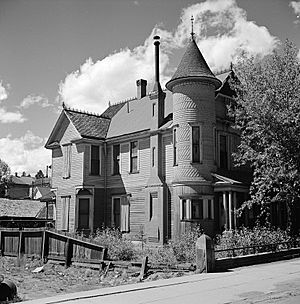
Historic Sites and Districts
The Leadville Historic District was named a National Historic Landmark District in 1961. This area includes 67 mines east of the city, up to 12,000-foot (3,700 m) high. It also covers a part of the town. Important historic buildings are the Tabor Grand Hotel, St George's Church, Temple Israel, the African Methodist Episcopal Church (built 1881), the Annunciation Church, Tabor Opera House, City Hall, Healy House, Dexter Cabin, Engelbach House, Tabor House, and the Golden Burro Cafe and Lounge. There are also mining structures and small homes.
The National Mining Hall of Fame on West 9th Street celebrates the work of miners and people who work with natural resources. It is listed on the National Register of Historic Places. Major exhibits include a detailed model railroad, a walk-through copy of an underground mine, and the Gold Rush Room with real gold samples. There is also a large collection of minerals and a mining art gallery. The site also includes the Matchless Mine and cabin, which was the home of Baby Doe Tabor.
Some historic sites are connected by the Mineral Belt National Recreation Trail. This is an 11.6-mile (18.7 km) trail for biking and walking that goes around Leadville. It also goes through the historic mining district. Parts of it follow old railroad beds from mining camps. Signs along the trail tell stories and show photos of what was there over a century ago. The trail is easy to follow and has signs for altitude and distance. It is also accessible for wheelchairs and strollers.
The Leadville National Fish Hatchery was created in 1889 to help increase the number of fish in inland waters.
Camp Hale is about 15 miles (24 km) north of Leadville. It was a U.S. Army training center built in 1942 for the 10th Mountain Division. Some of the best skiers in the country were instructors there. Soldiers learned mountain climbing, skiing, and how to survive in cold weather. They also trained with weapons. When it was fully running, about 15,000 soldiers lived there. Leadville was the only place for fun for the trainees. In 2019, Camp Hale became a National Historic Site. It has a self-guided tour with signs at ten stops. In 2022, President Biden made the 53,804-acre Camp Hale-Continental Divide National Monument. This protects the area's important history, nature, and recreation.
About 10 miles (16 km) north of Leadville, the old downhill ski slope, Cooper Hill, is now the Ski Cooper resort. It is on top of Tennessee Pass on the Continental Divide. Much of the area is above the tree line, offering amazing views of the Sawatch Range peaks. A memorial to the troops of the 10th Mountain Division is at the top.
The Evergreen Cemetery was Leadville's first cemetery, started on November 1, 1879.
The town's first library was built in 1904. A federal building was built in 1905 on Harrison Avenue and 8th Street. It was the town's post office until 1973.
Events and Festivals
Boom Days is held on the first full weekend of August. It celebrates the city's mining past. This event has been recognized by Congress. The three-day festival includes mining competitions and burro racing. There are also motorcycle games, a rod and gun show, live music, a craft fair, and a parade.
The annual skijoring event and Crystal Carnival happen in March. This is a family event where horses pull skiers. It has been happening since the 1960s. The town often has small parades downtown, like the fun St. Patrick's Day Practice Parade.
The Leadville Trail 100 is a very long running race, an ultramarathon. It takes place every August since 1983. The course goes around Turquoise Lake, over Hagerman Pass, through Twin Lakes, and across the Arkansas River. It also goes up and over Hope Pass to the ghost town of Winfield.
The "Route of the Silver Kings" is a driving tour of the 20-square-mile (52 km2) historic mining district. The tour passes mines, power plants, ghost towns, and old mining camps.

Parks and Recreation
Leadville is located within the San Isabel National Forest. It is surrounded by three wilderness areas. This makes it a popular place for hikers and campers. The Mount Massive Wilderness and Buffalo Peaks Wilderness are within 10 miles (16 km) of the city. The Collegiate Peaks Wilderness is within 20 miles (32 km).
Mosquito Pass is east of Leadville. You can only cross it on foot, with an off-road motorcycle, or with a special four-wheel drive vehicle. It is usually only open during the summer months.
The Mineral Belt Trail is an 11.6-mile (18.7 km) paved trail around the city. It opened in 2000 and is for walking, biking, and inline skating. There are five places to access the trail for shorter walks: Ice Palace Park, Lake County Middle School, Dutch Henry Hill, California Gulch, and the East 5th Street Bridge. The Mineral Belt Trail is fully accessible for wheelchairs and strollers.
Education
Schools in Leadville
Leadville's schools from kindergarten to 12th grade are part of the Lake County School District.
Higher Education
Leadville has a campus of Colorado Mountain College. At an elevation of 10,200 feet, CMC Leadville is the highest college campus in the United States. The Leadville campus is also home to Colorado Mountain College's cross-country team.
Transportation
Air and Road Travel
Leadville is served by Lake County Airport. This is North America's highest public airport, at an altitude of 9,934 feet. However, there are no regular airline flights from this airport. The closest airports with scheduled flights are Eagle County Regional Airport and Aspen/Pitkin County Airport, both about 62 miles (100 km) away.
Highways
 US 24 is a highway that runs east-west. Its western end is just 32 miles (51 km) north of Leadville. It is the main route to the Eagle-Vail valley to the northwest and Colorado Springs, 128 miles (206 km) to the southeast.
US 24 is a highway that runs east-west. Its western end is just 32 miles (51 km) north of Leadville. It is the main route to the Eagle-Vail valley to the northwest and Colorado Springs, 128 miles (206 km) to the southeast. State Highway 91 is a 22.5-mile (36.2 km) highway. It connects Leadville with Interstate 70 near Copper Mountain. This is the fastest way to get from Leadville to Denver, which is 100 miles (161 km) away.
State Highway 91 is a 22.5-mile (36.2 km) highway. It connects Leadville with Interstate 70 near Copper Mountain. This is the fastest way to get from Leadville to Denver, which is 100 miles (161 km) away.- The Top of the Rockies Byway is a special highway. It was named a National Scenic Byway in 1998. This highway travels 75 miles (121 km) starting in Aspen and going through Leadville to either Minturn or Copper Mountain.
Railways
- On July 22, 1880, the Denver & Rio Grande Railway arrived in Leadville.
- The former Colorado & Southern Railway line from Leadville to Climax is now a tourist line. It is operated by the Leadville, Colorado & Southern Railroad.
See also
 In Spanish: Leadville para niños
In Spanish: Leadville para niños



